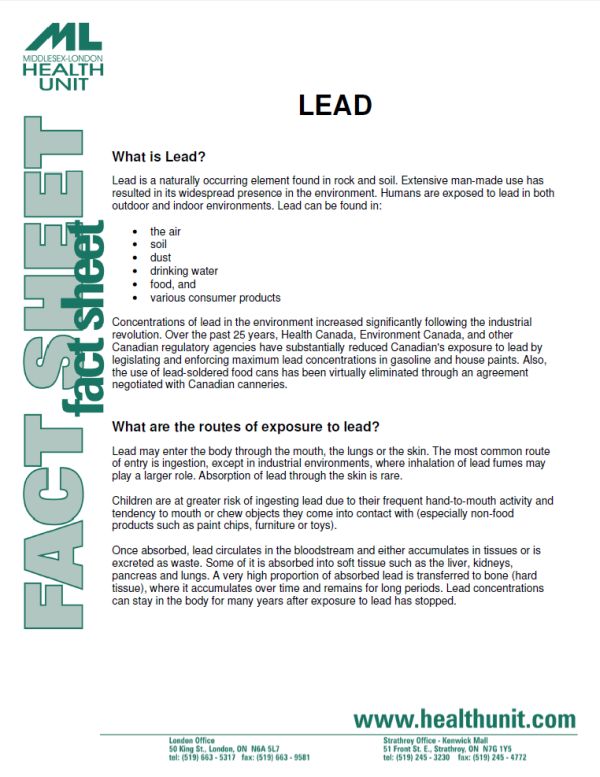Contact Us
To speak with a Public Health Inspector on the Environmental Health Team about lead, please call:
- 519-663-5317 ext. 2300
Lead is a naturally occurring element found in rock and soil. Extensive man-made use has resulted in its widespread presence in the environment. View the fact sheet below or this web page for more information on lead.
 Lead Fact Sheet (PDF 319KB)
Lead Fact Sheet (PDF 319KB)To speak with a Public Health Inspector on the Environmental Health Team about lead, please call:
Humans are exposed to lead in both outdoor and indoor environments. Lead can be found in:
Concentrations of lead in the environment increased significantly following the industrial revolution. Over the past 25 years, Health Canada, Environment Canada, and other Canadian regulatory agencies have substantially reduced Canadian's exposure to lead by legislating and enforcing maximum lead concentrations in gasoline and house paints. Also, the use of lead-soldered food cans has been virtually eliminated through an agreement negotiated with Canadian canneries.
Lead may enter the body through the mouth, the lungs or the skin. The most common route of entry is ingestion, except in industrial environments, where inhalation of lead fumes may play a larger role. Absorption of lead through the skin is rare.
Children are at greater risk of ingesting lead due to their frequent hand-to-mouth activity and tendency to mouth or chew objects they come into contact with (especially non-food products such as paint chips, furniture or toys).
Once absorbed, lead circulates in the bloodstream and either accumulates in tissues or is excreted as waste. Some of it is absorbed into soft tissue such as the liver, kidneys, pancreas and lungs. A very high proportion of absorbed lead is transferred to bone (hard tissue), where it accumulates over time and remains for long periods. Lead concentrations can stay in the body for many years after exposure to lead has stopped.
Some of the more prominent symptoms of lead poisoning include headaches, irritability, abdominal pain, vomiting, anemia (general weakness, paleness), weight loss, poor attention span, noticeable learning difficulty, slowed speech development and hyperactivity. However, at very low exposure levels, lead may not produce specific symptoms, but still can produce subtle adverse effects on children's development.
Paints made before 1950 contained large amounts of lead. In fact, some paint made in the 1940s contained up to 50% lead by dry weight. If your home was built before 1960, it was likely painted with lead-based paint. Since the 1950's, the use of lead has been more common in exterior paint than interior paint. Subsequently, the use of lead in paints decreased significantly. Currently, under the Hazardous Products Act, lead levels in indoor paint are limited to 0.5% by dry weight. There are proposed regulatory changes for both interior and exterior consumer paints to limit lead in paints to 0.06% by dry weight.
In homes built after 1980, there is little need for concern about lead levels in interior paints. All post-1992 consumer paint produced in Canada or the US for indoor use is virtually lead-free.
For more information on lead, view:
To speak to a Public Health Inspector on the Environmental Health Team about lead, please call:
Please note: The source of this information is Health Canada’s "Lead" and "Lead Information Package" web pages. The information is a copy of the version available at the URL in the references section below.